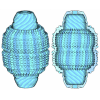[English] 日本語
 Yorodumi
Yorodumi- PDB-7og1: AP2 clathrin adaptor core in complex with cargo peptide and FCHO2 -
+ Open data
Open data
- Basic information
Basic information
| Entry | Database: PDB / ID: 7og1 | ||||||
|---|---|---|---|---|---|---|---|
| Title | AP2 clathrin adaptor core in complex with cargo peptide and FCHO2 | ||||||
 Components Components |
| ||||||
 Keywords Keywords | ENDOCYTOSIS / clathrin-mediated endocytosis (CME) / protein recycling / plasma membrane | ||||||
| Function / homology |  Function and homology information Function and homology informationmembrane invagination / LDL clearance / WNT5A-dependent internalization of FZD2, FZD5 and ROR2 / Gap junction degradation / Formation of annular gap junctions / WNT5A-dependent internalization of FZD4 / WNT5A-dependent internalization of FZD2, FZD5 and ROR2 / Nef Mediated CD8 Down-regulation / Trafficking of GluR2-containing AMPA receptors / LDL clearance ...membrane invagination / LDL clearance / WNT5A-dependent internalization of FZD2, FZD5 and ROR2 / Gap junction degradation / Formation of annular gap junctions / WNT5A-dependent internalization of FZD4 / WNT5A-dependent internalization of FZD2, FZD5 and ROR2 / Nef Mediated CD8 Down-regulation / Trafficking of GluR2-containing AMPA receptors / LDL clearance / Retrograde neurotrophin signalling / Retrograde neurotrophin signalling / VLDLR internalisation and degradation / WNT5A-dependent internalization of FZD2, FZD5 and ROR2 / WNT5A-dependent internalization of FZD4 / Trafficking of GluR2-containing AMPA receptors / clathrin adaptor complex / VLDLR internalisation and degradation / WNT5A-dependent internalization of FZD4 / Recycling pathway of L1 / extrinsic component of presynaptic endocytic zone membrane / MHC class II antigen presentation / regulation of vesicle size / postsynaptic endocytic zone / AP-2 adaptor complex / postsynaptic neurotransmitter receptor internalization / Cargo recognition for clathrin-mediated endocytosis / Recycling pathway of L1 / Retrograde neurotrophin signalling / clathrin-coated endocytic vesicle / membrane coat / Clathrin-mediated endocytosis / clathrin coat assembly / positive regulation of synaptic vesicle endocytosis / Cargo recognition for clathrin-mediated endocytosis / clathrin adaptor activity / Clathrin-mediated endocytosis / LDL clearance / vesicle budding from membrane / clathrin-dependent endocytosis / MHC class II antigen presentation / signal sequence binding / coronary vasculature development / Nef Mediated CD4 Down-regulation / positive regulation of protein localization to membrane / endolysosome membrane / neurotransmitter secretion / clathrin-coated vesicle / aorta development / ventricular septum development / Neutrophil degranulation / low-density lipoprotein particle receptor binding / clathrin binding / phosphatidylserine binding / Trafficking of GluR2-containing AMPA receptors / Recycling pathway of L1 / positive regulation of receptor internalization / positive regulation of endocytosis / EPH-ephrin mediated repulsion of cells / synaptic vesicle endocytosis / negative regulation of protein localization to plasma membrane / vesicle-mediated transport / clathrin-coated pit / phosphatidylinositol-4,5-bisphosphate binding / phosphatidylinositol binding / MHC class II antigen presentation / protein serine/threonine kinase binding / VLDLR internalisation and degradation / protein localization to plasma membrane / intracellular protein transport / kidney development / clathrin-coated endocytic vesicle membrane / receptor internalization / kinase binding / cytoplasmic side of plasma membrane / terminal bouton / disordered domain specific binding / synaptic vesicle / endocytic vesicle membrane / Cargo recognition for clathrin-mediated endocytosis / presynapse / Clathrin-mediated endocytosis / protein-containing complex assembly / cytoplasmic vesicle / Potential therapeutics for SARS / transmembrane transporter binding / postsynapse / protein domain specific binding / synapse / lipid binding / protein kinase binding / protein-containing complex binding / glutamatergic synapse / identical protein binding / membrane / plasma membrane / cytoplasm / cytosol Similarity search - Function | ||||||
| Biological species |   Homo sapiens (human) Homo sapiens (human) | ||||||
| Method |  X-RAY DIFFRACTION / X-RAY DIFFRACTION /  SYNCHROTRON / SYNCHROTRON /  MOLECULAR REPLACEMENT / Resolution: 3.25 Å MOLECULAR REPLACEMENT / Resolution: 3.25 Å | ||||||
 Authors Authors | Zaccai, N.R. / Kelly, B.T. / Evans, P.R. / Owen, D.J. | ||||||
| Funding support |  United Kingdom, 1items United Kingdom, 1items
| ||||||
 Citation Citation |  Journal: Sci Adv / Year: 2022 Journal: Sci Adv / Year: 2022Title: FCHO controls AP2's initiating role in endocytosis through a PtdIns(4,5)P-dependent switch. Authors: Nathan R Zaccai / Zuzana Kadlecova / Veronica Kane Dickson / Kseniya Korobchevskaya / Jan Kamenicky / Oleksiy Kovtun / Perunthottathu K Umasankar / Antoni G Wrobel / Jonathan G G Kaufman / ...Authors: Nathan R Zaccai / Zuzana Kadlecova / Veronica Kane Dickson / Kseniya Korobchevskaya / Jan Kamenicky / Oleksiy Kovtun / Perunthottathu K Umasankar / Antoni G Wrobel / Jonathan G G Kaufman / Sally R Gray / Kun Qu / Philip R Evans / Marco Fritzsche / Filip Sroubek / Stefan Höning / John A G Briggs / Bernard T Kelly / David J Owen / Linton M Traub /      Abstract: Clathrin-mediated endocytosis (CME) is the main mechanism by which mammalian cells control their cell surface proteome. Proper operation of the pivotal CME cargo adaptor AP2 requires membrane- ...Clathrin-mediated endocytosis (CME) is the main mechanism by which mammalian cells control their cell surface proteome. Proper operation of the pivotal CME cargo adaptor AP2 requires membrane-localized Fer/Cip4 homology domain-only proteins (FCHO). Here, live-cell enhanced total internal reflection fluorescence-structured illumination microscopy shows that FCHO marks sites of clathrin-coated pit (CCP) initiation, which mature into uniform-sized CCPs comprising a central patch of AP2 and clathrin corralled by an FCHO/Epidermal growth factor potential receptor substrate number 15 (Eps15) ring. We dissect the network of interactions between the FCHO interdomain linker and AP2, which concentrates, orients, tethers, and partially destabilizes closed AP2 at the plasma membrane. AP2's subsequent membrane deposition drives its opening, which triggers FCHO displacement through steric competition with phosphatidylinositol 4,5-bisphosphate, clathrin, cargo, and CME accessory factors. FCHO can now relocate toward a CCP's outer edge to engage and activate further AP2s to drive CCP growth/maturation. #1: Journal: Acta Crystallogr., Sect. D: Biol. Crystallogr. / Year: 2012 Title: Towards automated crystallographic structure refinement with phenix.refine. Authors: Afonine, P.V. | ||||||
| History |
|
- Structure visualization
Structure visualization
| Structure viewer | Molecule:  Molmil Molmil Jmol/JSmol Jmol/JSmol |
|---|
- Downloads & links
Downloads & links
- Download
Download
| PDBx/mmCIF format |  7og1.cif.gz 7og1.cif.gz | 395.2 KB | Display |  PDBx/mmCIF format PDBx/mmCIF format |
|---|---|---|---|---|
| PDB format |  pdb7og1.ent.gz pdb7og1.ent.gz | Display |  PDB format PDB format | |
| PDBx/mmJSON format |  7og1.json.gz 7og1.json.gz | Tree view |  PDBx/mmJSON format PDBx/mmJSON format | |
| Others |  Other downloads Other downloads |
-Validation report
| Summary document |  7og1_validation.pdf.gz 7og1_validation.pdf.gz | 507.8 KB | Display |  wwPDB validaton report wwPDB validaton report |
|---|---|---|---|---|
| Full document |  7og1_full_validation.pdf.gz 7og1_full_validation.pdf.gz | 577.7 KB | Display | |
| Data in XML |  7og1_validation.xml.gz 7og1_validation.xml.gz | 66.2 KB | Display | |
| Data in CIF |  7og1_validation.cif.gz 7og1_validation.cif.gz | 88.4 KB | Display | |
| Arichive directory |  https://data.pdbj.org/pub/pdb/validation_reports/og/7og1 https://data.pdbj.org/pub/pdb/validation_reports/og/7og1 ftp://data.pdbj.org/pub/pdb/validation_reports/og/7og1 ftp://data.pdbj.org/pub/pdb/validation_reports/og/7og1 | HTTPS FTP |
-Related structure data
| Related structure data |  7ofpC  7ohiC 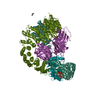 7ohoC 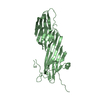 7ohzC  7oi5C 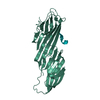 7oiqC  7oitC 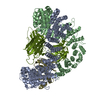 7z5cC  2xa7S S: Starting model for refinement C: citing same article ( |
|---|---|
| Similar structure data | Similarity search - Function & homology  F&H Search F&H Search |
- Links
Links
- Assembly
Assembly
| Deposited unit | 
| ||||||||
|---|---|---|---|---|---|---|---|---|---|
| 1 |
| ||||||||
| Unit cell |
|
- Components
Components
-AP-2 complex subunit ... , 4 types, 5 molecules AAABBBMMMCCCSSS
| #1: Protein | Mass: 69656.297 Da / Num. of mol.: 1 Source method: isolated from a genetically manipulated source Source: (gene. exp.)   | ||
|---|---|---|---|
| #2: Protein | Mass: 66953.195 Da / Num. of mol.: 1 Source method: isolated from a genetically manipulated source Source: (gene. exp.)  Homo sapiens (human) / Gene: AP2B1, ADTB2, CLAPB1 / Production host: Homo sapiens (human) / Gene: AP2B1, ADTB2, CLAPB1 / Production host:  | ||
| #3: Protein | Mass: 51044.113 Da / Num. of mol.: 2 Source method: isolated from a genetically manipulated source Source: (gene. exp.)   #4: Protein | | Mass: 17038.688 Da / Num. of mol.: 1 Source method: isolated from a genetically manipulated source Source: (gene. exp.)   |
-Protein / Protein/peptide , 2 types, 3 molecules GGGDDDPPP
| #5: Protein | Mass: 17111.500 Da / Num. of mol.: 2 Source method: isolated from a genetically manipulated source Source: (gene. exp.)  Homo sapiens (human) / Gene: FCHO2 / Production host: Homo sapiens (human) / Gene: FCHO2 / Production host:  #6: Protein/peptide | | Mass: 808.860 Da / Num. of mol.: 1 / Source method: obtained synthetically / Source: (synth.)  Homo sapiens (human) Homo sapiens (human) |
|---|
-Experimental details
-Experiment
| Experiment | Method:  X-RAY DIFFRACTION / Number of used crystals: 1 X-RAY DIFFRACTION / Number of used crystals: 1 |
|---|
- Sample preparation
Sample preparation
| Crystal | Density Matthews: 2.56 Å3/Da / Density % sol: 51.99 % |
|---|---|
| Crystal grow | Temperature: 289 K / Method: vapor diffusion, hanging drop Details: Crystals of AP-2 in complex with FCHO2 linker and TGN38 peptide, supplemented with 10mM K Na Tartrate, grew in sitting drops with reservoir 0.1M Mg formate dehydrate, 10% to 15% PEG 3350. ...Details: Crystals of AP-2 in complex with FCHO2 linker and TGN38 peptide, supplemented with 10mM K Na Tartrate, grew in sitting drops with reservoir 0.1M Mg formate dehydrate, 10% to 15% PEG 3350. The crystals were cryo-protected with 0.1M Mg formate dehydrate, 13% PEG 3350, 18-24% Glycerol and 1mg/ml of peptide. Temp details: Room temperature |
-Data collection
| Diffraction | Mean temperature: 100 K / Serial crystal experiment: N |
|---|---|
| Diffraction source | Source:  SYNCHROTRON / Site: SYNCHROTRON / Site:  Diamond Diamond  / Beamline: I04 / Wavelength: 0.92001 Å / Beamline: I04 / Wavelength: 0.92001 Å |
| Detector | Type: DECTRIS PILATUS3 6M / Detector: PIXEL / Date: Apr 28, 2017 |
| Radiation | Protocol: SINGLE WAVELENGTH / Monochromatic (M) / Laue (L): M / Scattering type: x-ray |
| Radiation wavelength | Wavelength: 0.92001 Å / Relative weight: 1 |
| Reflection | Resolution: 3.25→78.58 Å / Num. obs: 38355 / % possible obs: 100 % / Redundancy: 6.6 % / CC1/2: 0.998 / Rmerge(I) obs: 0.133 / Rpim(I) all: 0.086 / Rrim(I) all: 0.159 / Net I/σ(I): 7.2 |
| Reflection shell | Resolution: 3.25→3.39 Å / Redundancy: 6 % / Rmerge(I) obs: 2.123 / Mean I/σ(I) obs: 0.8 / Num. unique obs: 4690 / CC1/2: 0.366 / Rpim(I) all: 1.465 / Rrim(I) all: 2.59 / % possible all: 100 |
- Processing
Processing
| Software |
| |||||||||||||||||||||||||||||||||||||||||||||||||||||||||||||||||||||||||||||||||||||||||||||||||||||||||||||||||||||||||||||||||||||||||||||||||||||||||||
|---|---|---|---|---|---|---|---|---|---|---|---|---|---|---|---|---|---|---|---|---|---|---|---|---|---|---|---|---|---|---|---|---|---|---|---|---|---|---|---|---|---|---|---|---|---|---|---|---|---|---|---|---|---|---|---|---|---|---|---|---|---|---|---|---|---|---|---|---|---|---|---|---|---|---|---|---|---|---|---|---|---|---|---|---|---|---|---|---|---|---|---|---|---|---|---|---|---|---|---|---|---|---|---|---|---|---|---|---|---|---|---|---|---|---|---|---|---|---|---|---|---|---|---|---|---|---|---|---|---|---|---|---|---|---|---|---|---|---|---|---|---|---|---|---|---|---|---|---|---|---|---|---|---|---|---|---|
| Refinement | Method to determine structure:  MOLECULAR REPLACEMENT MOLECULAR REPLACEMENTStarting model: 2xa7 Resolution: 3.25→76.662 Å / Cor.coef. Fo:Fc: 0.95 / Cor.coef. Fo:Fc free: 0.903 / SU B: 44.28 / SU ML: 0.687 / Cross valid method: FREE R-VALUE / ESU R Free: 0.636
| |||||||||||||||||||||||||||||||||||||||||||||||||||||||||||||||||||||||||||||||||||||||||||||||||||||||||||||||||||||||||||||||||||||||||||||||||||||||||||
| Solvent computation | Ion probe radii: 0.8 Å / Shrinkage radii: 0.8 Å / VDW probe radii: 1.2 Å / Solvent model: MASK BULK SOLVENT | |||||||||||||||||||||||||||||||||||||||||||||||||||||||||||||||||||||||||||||||||||||||||||||||||||||||||||||||||||||||||||||||||||||||||||||||||||||||||||
| Displacement parameters | Biso mean: 135.397 Å2
| |||||||||||||||||||||||||||||||||||||||||||||||||||||||||||||||||||||||||||||||||||||||||||||||||||||||||||||||||||||||||||||||||||||||||||||||||||||||||||
| Refinement step | Cycle: LAST / Resolution: 3.25→76.662 Å
| |||||||||||||||||||||||||||||||||||||||||||||||||||||||||||||||||||||||||||||||||||||||||||||||||||||||||||||||||||||||||||||||||||||||||||||||||||||||||||
| Refine LS restraints |
| |||||||||||||||||||||||||||||||||||||||||||||||||||||||||||||||||||||||||||||||||||||||||||||||||||||||||||||||||||||||||||||||||||||||||||||||||||||||||||
| LS refinement shell |
|
 Movie
Movie Controller
Controller






 PDBj
PDBj

















